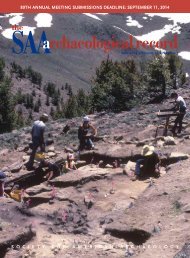SAA
Nov2016_web
Nov2016_web
Create successful ePaper yourself
Turn your PDF publications into a flip-book with our unique Google optimized e-Paper software.
VIDEO GAMES AND ARCHAEOLOGY<br />
SURVIVING THE MIDDLE AGES<br />
NOTES ON CRAFTING GAMEPLAY FOR A DIGITAL HISTORICAL GAME<br />
Juan F. Hiriart<br />
Juan F. Hiriart is a lecturer in the Department of Computer and Videogames at the University of Salford in Greater Manchester, United Kingdom.<br />
“ The past is a foreign country: they do things differently<br />
there,” wrote L. P. Hartley (2002 [1953]) in the opening<br />
lines of his novel The Go-Between. For me, the past<br />
has always been fascinating, and so the multiplicity of ways<br />
in which people connect with history in one way or another.<br />
From the reading of historical fiction, the watching of films<br />
based on past events, or the engagement and participation in<br />
highly demanding forms of reenactment, a surprisingly<br />
large number of people find pleasure and satisfaction in traveling<br />
back in time. For them, “the past is not only present,”<br />
as Rosenzweig and Thelen noted, “it is part of the present”<br />
(1999:178). As an avid gamer, and professional game developer,<br />
my interest in the past gravitated naturally to the study<br />
of the relationships between all these forms of historical<br />
engagement and digital games, arguably one of the most<br />
important media in the current cultural landscape.<br />
For the last four years, I have been directing this interest to<br />
Ph.D. research investigating the dynamic intersections<br />
between history, learning, and computer games. Defined as<br />
practice-based research, this study builds up from the development<br />
of a historical game in which, giving myself complete<br />
freedom to experiment and put to the test different<br />
assumptions about historical gameplay, has become a useful<br />
tool to investigate the ways in which digital game technologies<br />
can be used to foster the meaningful and critical understanding<br />
of the past.<br />
Following nothing more than my personal interest and intuition,<br />
I decided to situate my game in the early medieval<br />
period of Anglo-Saxon England. This turbulent moment of<br />
British history has always been interesting to me, as it was<br />
the time in which this land, although on the brink of being<br />
colonized by Danish invaders, became a single unified state<br />
with an identity that lasts to this day. Despite being very<br />
interested in this time period, I had to recognize that my<br />
knowledge of medieval British history was sketchy at best, so<br />
a good part of my energies at the beginning of the research<br />
were devoted to immersing myself in the complexities of the<br />
Anglo-Saxon world. To become myself an informed traveler<br />
in this particular period, I selected and studied a wide selection<br />
of historical sources and materials. These were not<br />
restricted to academic texts but also considered a heterogeneous<br />
collection of historical engagements, the type of which<br />
Katie King (2008:12) encapsulates as “pastpresents,” forms<br />
“in which pasts and presents very literally mutually construct<br />
each other.” Among these, I thoroughly enjoyed the research<br />
of heritage sites, experimental archaeological reconstructions,<br />
reenactment groups, television series such as the<br />
Irish-Canadian production Vikings, and the excellent collection<br />
of Bernard Cornwell’s books The Warrior Chronicles, very<br />
recently turned into a television series by BBC America.<br />
A key part of any design process is the writing of a program,<br />
loosely defined as a “wish list” containing a set of criteria on<br />
which the design is based, and by which it will be evaluated.<br />
In this case, the design program had to consider at least four<br />
interdependent and interconnected in-game systems: representation,<br />
simulation, narrative, and play. As representation,<br />
the historical game had to allow players to visit the Anglo-<br />
Saxon world, granting the exploration of representative buildings,<br />
the meaningful interaction with believable characters,<br />
and the manipulation of objects and tools of cultural significance.<br />
As simulation, the world needed to be augmented with<br />
procedural algorithms communicating “how things worked”<br />
at the time. Non-player agents had to exhibit believable behaviors,<br />
communicating social and cultural patterns of interaction<br />
with other agents and the environment and reflecting the<br />
complex layers of meaning associated with the struggle of<br />
surviving in the harsh living conditions of medieval time. As<br />
narrative, the game had to convey factual information about<br />
the historical period while also letting players participate in<br />
the construction of a nonlinear storyline. Finally, and perhaps<br />
most importantly, the game needed to work as a game. It<br />
needed to be engaging and fun, setting into motion all the<br />
mechanisms that make games intrinsically motivating.<br />
34 The <strong>SAA</strong> Archaeological Record • November 2016




